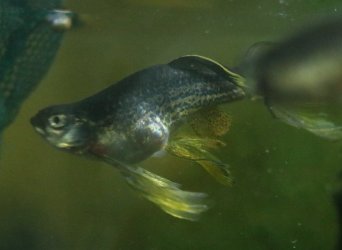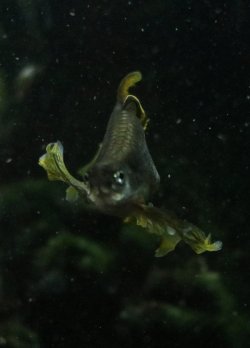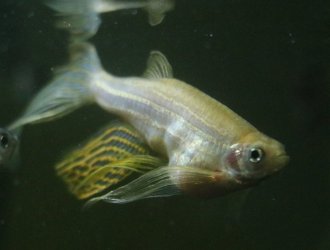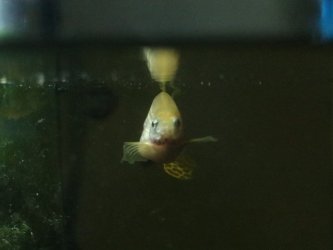EmilyS
New Member
One of my fish has had a lump on her side for about 6 months and the other has had it about 4 months. I originally thought it was a tumor of some kind, and since it doesn't bother the fish at all, I haven't done anything about it. These fish are all two years old.
I have found several threads asking very similar questions, several on this forum, and several which never received any replies at all. The most closely related is here.
I don't have any older pictures to show growth over time, but these lumps have been growing at a constant slow rate at about the same speed on both fish. I don't know how quickly the lump developed at first (could have been overnight, could have been over the course of a month) because the coloration and location made it difficult to see.
I apologize for how dark the photos are. It's hard to get brighter pictures that aren't blurry. I tried to get pictures from both the side and the front for both fish.




As you can see, the Gold Longfin Danio has a much larger growth with several smaller lumps further down her body. The Leopard Longfin Danio has a smaller lump that is almost pointy from certain angles. They are entirely internal and grow slowly enough that they never rupture the skin.
The lumps haven't been affected by water changes, moving three times, or raising catfish fry and danio fry in the same aquarium. Both fish act completely normal. They are active, interact with the other fish, and eat normally. All the other fish are also fine and don't have growths.
Has anyone ever seen this in their danios (even if you never found a cause)? Anyone have any ideas as to what it could be? Does anyone know if the problems are related or if it's just a coincidence that both fish have similar looking problems?
Some more info about the tank:
Size: 10 gallons + 1 gallon refugium (for fry)
Fish: 2 longfin leopard danios, 3 longfin gold danios, 4 peppered cory catfish, 1 julii cory catfish, 9 gold danio fry and lots of juvenile peppered cory catfish. I'm moving most of the fish to a 29 gallon as soon as the pH stabilizes in the new tank.
Temperature: 78F
Plants: one small java fern
I have found several threads asking very similar questions, several on this forum, and several which never received any replies at all. The most closely related is here.
I don't have any older pictures to show growth over time, but these lumps have been growing at a constant slow rate at about the same speed on both fish. I don't know how quickly the lump developed at first (could have been overnight, could have been over the course of a month) because the coloration and location made it difficult to see.
I apologize for how dark the photos are. It's hard to get brighter pictures that aren't blurry. I tried to get pictures from both the side and the front for both fish.




As you can see, the Gold Longfin Danio has a much larger growth with several smaller lumps further down her body. The Leopard Longfin Danio has a smaller lump that is almost pointy from certain angles. They are entirely internal and grow slowly enough that they never rupture the skin.
The lumps haven't been affected by water changes, moving three times, or raising catfish fry and danio fry in the same aquarium. Both fish act completely normal. They are active, interact with the other fish, and eat normally. All the other fish are also fine and don't have growths.
Has anyone ever seen this in their danios (even if you never found a cause)? Anyone have any ideas as to what it could be? Does anyone know if the problems are related or if it's just a coincidence that both fish have similar looking problems?
Some more info about the tank:
Size: 10 gallons + 1 gallon refugium (for fry)
Fish: 2 longfin leopard danios, 3 longfin gold danios, 4 peppered cory catfish, 1 julii cory catfish, 9 gold danio fry and lots of juvenile peppered cory catfish. I'm moving most of the fish to a 29 gallon as soon as the pH stabilizes in the new tank.
Temperature: 78F
Plants: one small java fern
Last edited by a moderator:

